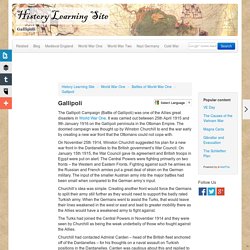

World War 1 – Teaching Resource « Teachers. Gallipoli2.htm. Gallipoli. The Gallipoli Campaign (Battle of Gallipoli) was one of the Allies great disasters in World War One.

It was carried out between 25th April 1915 and 9th January 1916 on the Gallipoli peninsula in the Ottoman Empire. The doomed campaign was thought up by Winston Churchill to end the war early by creating a new war front that the Ottomans could not cope with. On November 25th 1914, Winston Churchill suggested his plan for a new war front in the Dardanelles to the British government’s War Council. On January 15th 1915, the War Council gave its agreement and British troops in Egypt were put on alert. The Central Powers were fighting primarily on two fronts – the Western and Eastern Fronts. Churchill’s idea was simple. The Turks had joined the Central Powers in November 1914 and they were seen by Churchill as being the weak underbelly of those who fought against the Allies.
There is confusion as to what was decided at this meeting of the War Council. “It was not my business. Life in the Trenches. Life in the trenches during the First World War took many forms, and varied widely from sector to sector and from front to front.

Undoubtedly, it was entirely unexpected for those eager thousands who signed up for war in August 1914. A War of Movement? Indeed, the Great War - a phrase coined even before it had begun - was expected to be a relatively short affair and, as with most wars, one of great movement. The First World War was typified however by its lack of movement, the years of stalemate exemplified on the Western Front from autumn 1914 until spring 1918. Not that there wasn't movement at all on the Western Front during 1914-18; the war began dramatically with sweeping advances by the Germans through Belgium and France en route for Paris.
So what was life actually like for the men serving tours of duty in the line, be they front line, support or reserve trenches? Daily Death in the Trenches Rat Infestation Rats in their millions infested trenches. Schools Online World War One - Homepage. World War I (1914–1919): Overview. World War I took place between 1914 and 1918.

Although the conflict began in Europe, it ultimately involved countries as far away as the United States and Japan. At the time, the English-speaking world knew it as the “Great War”—the term “World War I” was applied decades later. Historians still actively disagree over the fundamental causes of the war. The period leading up to the war was a complex tangle of diplomacy and political maneuvering—many countries debated over strategies and alliances until nearly the last minute—and the first few weeks of the conflict were similarly chaotic and confusing. However, historians agree nearly unanimously about the war’s consequences: World War I led almost directly to World War II and set the stage for many other important events in the twentieth century.
Political tensions ran high in early twentieth-century Europe. At the same time, technological and industrial developments in Europe were advancing with unprecedented speed. History - World Wars: Summary of World War One. World War One main page. Worksheets - World war one. Historystuff.co.uk - Key Stage Three Activities Listings. BBC History - WW1.